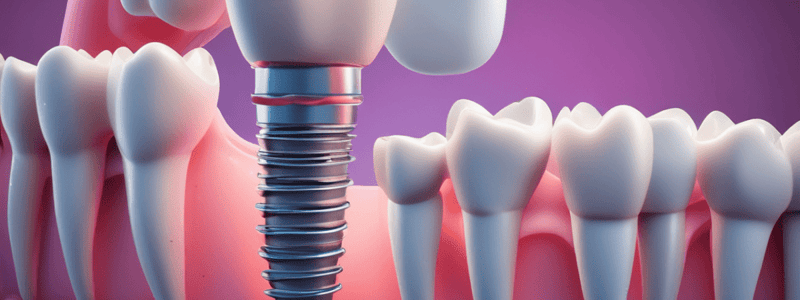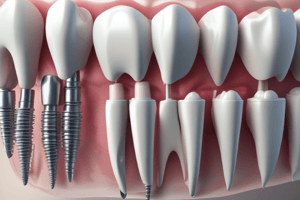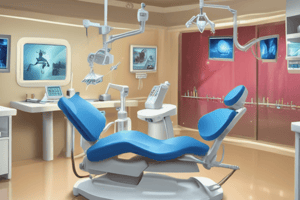Podcast
Questions and Answers
What is the typical location of the lingual nerve in relation to the osseous crest?
What is the typical location of the lingual nerve in relation to the osseous crest?
- 3 mm apical and 2 mm inferior from the lingual cortical plate
- 3 mm apical and 2 mm lingually from the lingual cortical plate
- 3 mm apical and 2 mm horizontally from the lingual cortical plate (correct)
- 3 mm apical and 2 mm buccally from the lingual cortical plate
What is the recommended location for incisions distal to the second molar?
What is the recommended location for incisions distal to the second molar?
- On the inferior border of the mandible
- On the crest of the ridge
- On the lingual aspect of the ridge
- On the buccal aspect of the ridge (correct)
What is the potential consequence of completely stripping the mentalis muscle from the mandible?
What is the potential consequence of completely stripping the mentalis muscle from the mandible?
- Decreased sensation in the chin area
- Appearance of a witch's chin (double chin) (correct)
- Difficulty in mouth opening
- Difficulty in mastication
What is the recommended approach if the mentalis muscle is reflected during a procedure?
What is the recommended approach if the mentalis muscle is reflected during a procedure?
What is the potential consequence of a severely resorbed ridge on the mylohyoid muscle?
What is the potential consequence of a severely resorbed ridge on the mylohyoid muscle?
What is the purpose of using a radiopaque marker during a CT scan?
What is the purpose of using a radiopaque marker during a CT scan?
What is the most common location of the mental foramen in the vertical dimension?
What is the most common location of the mental foramen in the vertical dimension?
What is the recommended safety margin when placing implants near the mental foramen?
What is the recommended safety margin when placing implants near the mental foramen?
What is the typical angle of the mental nerve as it emerges from the mental canal?
What is the typical angle of the mental nerve as it emerges from the mental canal?
Which of the following statements about the anterior loop of the mental foramen is CORRECT?
Which of the following statements about the anterior loop of the mental foramen is CORRECT?
What is the MOST COMMON horizontal location of the mental foramen?
What is the MOST COMMON horizontal location of the mental foramen?
What is the MOST LIKELY consequence if the bifurcation of the mandibular canal is not identified on radiographs?
What is the MOST LIKELY consequence if the bifurcation of the mandibular canal is not identified on radiographs?
What is the recommended approach to determine if an anterior loop of the mental nerve is present before placing an implant?
What is the recommended approach to determine if an anterior loop of the mental nerve is present before placing an implant?
How many nerve branches of the mental nerve typically emerge from the mental foramen?
How many nerve branches of the mental nerve typically emerge from the mental foramen?
Which statement is true regarding the incisive canal?
Which statement is true regarding the incisive canal?
If the incisive canal is large, what should be considered before placing an implant in that area?
If the incisive canal is large, what should be considered before placing an implant in that area?
What is the recommended approach for dealing with potential bleeding from the lingual foramen or lateral canals during implant placement?
What is the recommended approach for dealing with potential bleeding from the lingual foramen or lateral canals during implant placement?
What is the typical diameter range of the lingual foramen and lateral canals?
What is the typical diameter range of the lingual foramen and lateral canals?
Where is the infraorbital nerve typically found in relation to the infraorbital ridge?
Where is the infraorbital nerve typically found in relation to the infraorbital ridge?
What is the recommended length for a lateral window to avoid encroaching on the infraorbital nerve during a dental implant procedure?
What is the recommended length for a lateral window to avoid encroaching on the infraorbital nerve during a dental implant procedure?
Where is the greater palatine foramen typically located along the palate?
Where is the greater palatine foramen typically located along the palate?
How can the precise location of the greater palatine foramen be determined prior to flap elevation?
How can the precise location of the greater palatine foramen be determined prior to flap elevation?
In what percentage of cases is the greater palatine foramen found opposite the third molar?
In what percentage of cases is the greater palatine foramen found opposite the third molar?
What is a safe distance recommended between the greater palatine artery and the end of a surgical incision?
What is a safe distance recommended between the greater palatine artery and the end of a surgical incision?
What is the average height of the superior genial tubercle?
What is the average height of the superior genial tubercle?
What is the primary concern when reflecting the genioglossus muscle during implant procedures?
What is the primary concern when reflecting the genioglossus muscle during implant procedures?
Where is the mental foramen typically located in relation to the depressor anguli oris and depressor labii inferioris muscles?
Where is the mental foramen typically located in relation to the depressor anguli oris and depressor labii inferioris muscles?
When performing a GBR procedure in the buccal area, what is the primary reason for incising the buccinator and orbicularis oris muscles?
When performing a GBR procedure in the buccal area, what is the primary reason for incising the buccinator and orbicularis oris muscles?
What is the primary concern when using the mandibular ramus as a donor site for bone grafting?
What is the primary concern when using the mandibular ramus as a donor site for bone grafting?
What is the primary risk associated with the insertion of a subperiosteal implant in the pterygomandibular space?
What is the primary risk associated with the insertion of a subperiosteal implant in the pterygomandibular space?
Flashcards are hidden until you start studying




